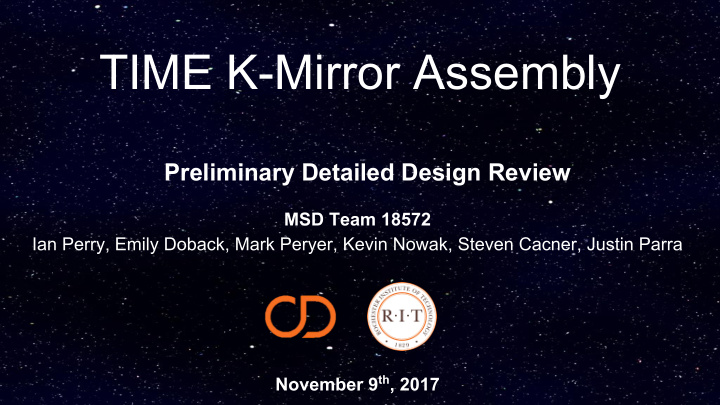



TIME K-Mirror Assembly Preliminary Detailed Design Review MSD Team 18572 Ian Perry, Emily Doback, Mark Peryer, Kevin Nowak, Steven Cacner, Justin Parra November 9 th , 2017
Background Kitt Peak 12m Antenna (KP12M) ● Located at University of Arizona Tomographic Ionized-carbon Mapping Experiment (TIME) ● Measure redshifted singly ionized carbon ● Measure molecular gas density ● Kinetic Sunyaev-Zel’dovich (kSZ) effect ● Collaboration with 5 other institutions University of Arizona
Problem Statement “K-mirror” Assembly ● Several mirrors connected to rotating mount ● Servo controlled ● Synchronizes to angle of rotation of telescope ● Transformation through three reflections ● Enables the use of sensor line-scanning
Customer Requirements Customer Category Importance Description Need # Assembly rotating is repeatable and CN1 1 accurate Assembly strong enough to keep mirrors CN2 1 in fixed positions relative to each other Functionality CN3 2 Electrostatic Discharge Protection CN4 2 Provide status to other sub-systems CN5 1 Control that is completely synchronous Portability CN6 1 Must be able to transport across country
Engineering Requirements Engineering Ideal Rqmt. # Importance Source Requirement Measure Margin Value (Metric) ER1 1 CN1 Fixed Angle degrees Dynamic +/- 0.15 Speed of ER2 1 CN1 degrees/second 1 +/- TBD rotation Surface Tolerance Type Tolerance Value (deg/mm) % Throughput Error Mirror 1 Decenter X 0.25 0.0425 Mirror 1 Decenter X -0.25 0.0426 (Not complete, only a few Mirror 1 Decenter Y 0.25 0.0429 selected values) Mirror 1 Decenter Z 0.25 0.0427 Mirror 1 Tilt X -0.25 0.17 Mirror 1 Tilt Y -0.25 0.0112
System Analysis: Functional Decomposition
Concept Development ● Cabin Rotates about Elevation Axis ( x - axis) ● 90 degrees of Rotation ○ Most conservative ● K - Mirror is within cabin
Concept Development - Cabin Interior Flange K-mirror assembly will replace this system
Concept Development - Flange ● K -mirror Assembly will be directly mounted to the flange shown ● Material INVAR 38 ● ID = 800 mm ● OD = 1500 mm ● t = 18 mm
Concept Development - Center Centric Center of Rotation Z Flange Y X Static Structure M1 M2 Legend MSD owned Motor Customer provided MSD w/ Customer Rigid Structure M3 (Dynamic, z-axis)
Center Centric Assembly - CAD Model
Center Centric Assembly - CAD Model
Engineering Analysis Material Max Max Displacement Displacement at 0deg [mm] at 90deg [mm] SW “Alloy 0.305 0.00005 Steel” ● Mass of rotating system Carpenter 0.461 0.00008 estimated using solid aluminum Invar 36 plates and multiplier for Carpenter 0.448 0.00008 counterweight Super Invar 32-5
Engineering Analysis - Arm Revision Material Max Max Displacement Displacement at 0deg [mm] at 90deg [mm] SW “Alloy 0.0368 0.0051 Steel”
K-Mirror Control System Architecture Telescope Control System Monitoring/Status Motor
Overall Telescope System Architecture
Data Communication ● Ethernet ● Fiber ○ Can easily interface with the Raspberry Pi ● TCP/IP socket protocol ○ Unknown data packet structure as of now ○ Local Area Connection (LAN) ■ Low latency
Data Communication - Fiber ● Fiber: ○ Use GPIO pins through interface board to convert to fiber
Raspberry Pi ● GPIO pins for motor control board connection ● Python to interface with GPIO pins ○ Fairly trivial ● Ethernet port for TCP/IP connections ○ Simple client/server python POC completed ● HDMI and 2 USB ports for display, keyboard, and mouse ● Runs operating system off SD card ○ Currently Raspbian but can be changed for application specific needs ● Powered from micro-USB
Stepper Motors ● High torque at low angular velocity ● Good angular repeatability ● Most common full step resolution: 1.8 degrees ● Control board allows for greater flexibility ○ Half-stepping, microstepping, or gear box are options Stepper Motor Torque Curve
Motor Controller ● RS232 interface ○ 115kbaud ● Ethernet interface ○ TCP/IP ○ 100 Base-T ● Encoder input ○ control feedback ● Capable of microstepping for increased angular resolution Galil DMC-3x01x single-axis motor controller
Closing the Loop ● Galil solutions: ○ End-point correction ○ Closed-loop microstepping ● Many other commercial solutions ● Rotary Encoders ○ Optical vs. Magnetic ○ Highest resolution: 0.009° per pulse
Questions?
CAD - Backup
CAD - Backup
CAD - Backup
Concept Development - Center Centric - Other Ideas X Y Z Load Bearing Support Arm (Help Deflections) Off set Motor and remove compressive load
Concept Development - Comparison What wasn’t included: Cost For both designs cost will be driven by the choice of materials as well as the geometry necessary to minimize the deflections. However, the Flange Centric Design will most likely require a much larger thrust bearing. Variability in design Center Centric Design leaves areas that can be used for extra support structures. The motor could also be offset to minimize the compressive loading on the motor.
Telescope
How we expect system to deflect: How to Design for Deflections:
Full Deflection Numbers
Tolerance Calculations
Concept Development - Flange Centric Center of Rotation Flange x Y Motor Z Rigid Structure (Dynamic, z-axis) M1 M2 M1 M2 Legend MSD owned Customer provided M3 M3 MSD w/ Customer
Concept Development - Comparison Center Flange Criteria Centric Centric + Weight - + System - Deflection - Modularity + Design Time + - Complexity + - + Denotes design is better for selected criteria
Control System Comparison Criteria Arduino FPGA Raspberry Pi Ease of Programming + + - Does not require host + - - computer to program Modular clock source + - - Computation speed - - + Cost + + - + Denotes design is better for selected criteria
Proposal Risk Likeliness Severity Risk Score Ideas to limit risk (0-10) (0-10) Create physical interference to keep the array Over Rotation of K - mirror 3 8 24 from rotating any further. Add more than one connection to the Flange, if Connection between Static 2 8 16 one fails the other can support until noticed by Structure and Flange fails operator. Mirrors fall outside of Design to allow minor adjustments using 5 4 20 tolerance screw/shimming techniques.
Recommend
More recommend